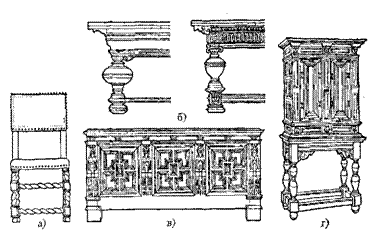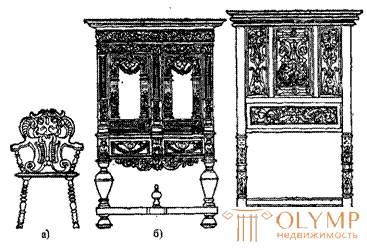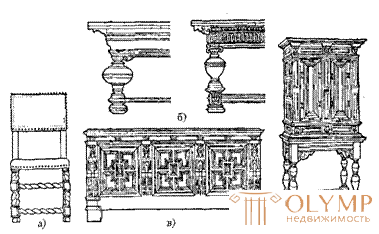
Germany. In the artistic culture of Germany, the transition from the Middle Ages to the Renaissance was delayed for many decades, so in the art of furniture for a long time coexisted two styles - Gothic and Renaissance. And the new was first manifested in the decor, and then in the design.

Fig. 1. Furniture of the German Renaissance (south of Germany)! a - a chair with a back in the form of carved orusmus, b — rhenian supplier | in — office
German Renaissance furniture is more picturesque and not as connected with antique images as Italian. For example, in the decoration of cabinets, chests, countertops are widely used technique of wooden set. The most common decoration motifs are: acanthus leaf, wreaths, medallions, cornucopia, grotesque, dolphins, volutes, cartouche, coat of arms.
German Renaissance furniture art has two varieties - northern and southern. In the north, furniture was made of oak and decorated with curly carving. Instead of decorative motifs of grotesques and candelabra, performed in low relief, began to use high-relief compositions. The ribs of the cabinets were treated with high, almost round threads, usually in the form of caryatids and Atlantes — herms with traditional curls in the form of a conical capitals overhead.
The chairs (fig. 1, a) of the German masters are perfect works of art. The nut board of the back is usually covered with carved grotesque ornamentation — a masquerade. But, breaking with the clarity of the Renaissance understanding, the mascarone motif turns into a fabulous pattern of curls and folds. With all the variety of options, you can find chimerically interpreted eyes, ears, nose, and a wide open mouth, usually cut through, so that you can easily carry a chair through a hole in your hand.
In the art of furniture in Germany, especially in the north, the process of crowding out gothic forms proceeded slowly. The peculiar coexistence of two styles, characteristic of the transitional stage, can be seen in the example of the Rhine supplier (Fig. 1, b) with somewhat massive forms.
In the south of Germany, where the influence of Italy was stronger, furniture craftsmen to architectural compositions, which can be clearly seen in the cabinet's decision (Fig. 1, c), whose front facade is a composition of a large architectural structure with arches, columns, developed cornice, etc. d.
In the second half of the XVI century. Augsburg carpenter Georg Renner invented a saw for cutting thin sheets of wood (plywood), which gave impetus to the development of wooden set technology in Germany, and then in the Netherlands and England.
The technique of wooden set from inlay is different in that it does not make indentations in the board for the typed pattern. The mosaic is not covered by a separate board, but by the finished base of the object, which is completely plastered with a set of precisely fitted plates forming the background. Most often used the motifs of flowers, curls, grotesques, in narrow places, a geometric pattern. The background and frame of the ornament were usually plastered with ash plates, and the set itself was made of linden, birch, and various sorts of fruit trees.
Wood was often stained: beech - yellow, saffron, pear soaked with dye and it replaced ebony.
Holland and Flanders. For the Dutch and Flanders Renaissance furniture characterized by simplicity and convenience. It was decorated with profiled eaves, member panels, arch motifs, balusters, openwork carvings, wooden mosaics (chess and other geometric ornaments) and intarsia with characteristic motifs: flowers in a vase, birds, butterflies, etc.

Fig. 2. Furniture of the Dutch Renaissance: a - stupas with twisted legs (about 1620), 6 — tables with supports-balusters, c - chest, d - wardrobe
Chairs were upholstered in leather, beds were made with a canopy, tables with thick tops were installed on massive chiseled legs in the form of balusters, and massive cabinets with several doors framed in frames and pilasters (Fig. 2).
England. Furniture art has been developing for a long time under the influence of European, mainly Dutch, designs. Renaissance style was not soon able to supplant the Gothic forms. A purely renaissance style was formed during the reign of Queen Elizabeth (1558–1603), but the finest creations of the carpentry art at that time were finely crafted wooden panels that sheathed the walls of the chambers in the castles of the English feudal lords. Furniture made in oak is still bulky.
The next period of the English Renaissance covers almost the entire XVII century. In the furniture forms, the influence of Italian masters is first felt, and later French and Dutch masters work at the English court. Tables, chairs and chairs have chiseled, and later bent legs. The surfaces of cabinets and chests are treated with carved panels with restless rhythm ornamental compositions. An indispensable subject of every English home was a table with lowered floors and sliding legs. Furniture is made not only from oak, but from walnut and various exotic woods. The furniture of the English Renaissance (1603–1688) is characterized by chiseled, less often bent legs.
Spain. Arabic art was a major influence on Spanish furniture.
The most characteristic of Spain is the cabinet, treated with varnish and openwork lining. Raised on the legs in the form of columns, the cabinet had either doors or a folding board, behind which were small drawers. In furniture frame products, chiseled parts are used. The backs and seats of the seats were covered with leather, which was trimmed with embossing, engraving, and gilding. The skin was attached with nails with large copper caps. The walls of the premises were also covered with leather.
Что бы оставить комментарий войдите
Комментарии (0)